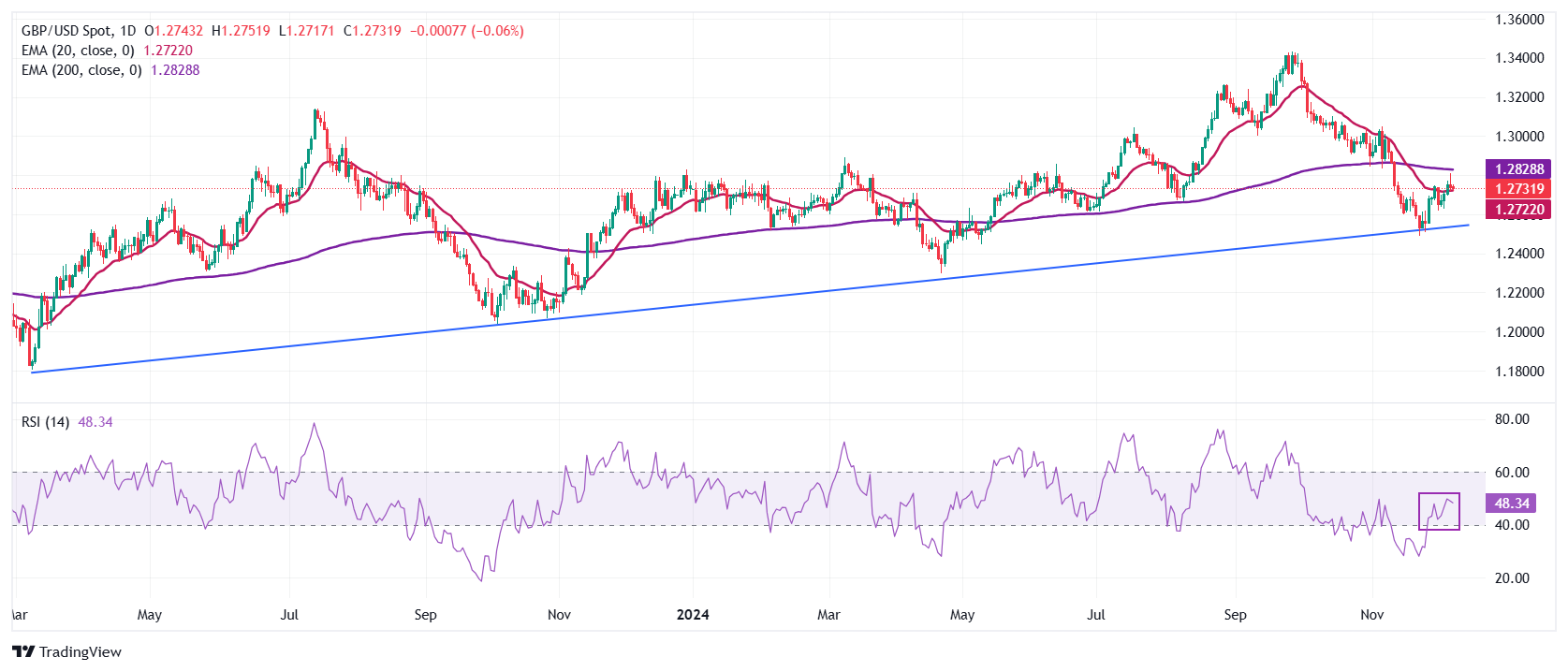GBP trades with caution against US Dollar even as Fed rate cut bets jump

- The Pound Sterling trades broadly stable against the US Dollar amid increasing bets that the Fed will cut interest rates by 25 bps on December 18.
- Fed Governor Michelle Bowman vowed to be cautious on interest rate cuts as price pressures are still elevated.
- Higher contributions by UK employers to the National Insurance norm in Labour’s first budget have weighed on labor demand, survey data shows.
The Pound Sterling (GBP) trades cautiously slightly above the key support of 1.2700 against the US Dollar (USD) on Monday. The GBP/USD pair trades broadly stable even though market participants are becoming increasingly confident that the Federal Reserve (Fed) will cut interest rates in its monetary policy meeting on December 18.
There is an 83% chance that the Fed will reduce its key borrowing rates by 25 basis points (bps) to 4.25%-4.50% next week, according to the CME FedWatch tool, up from the 62% seen a week ago. The US Dollar seems largely unbothered by increasing Fed rate cut bets, with the US Dollar Index (DXY) – which tracks the Greenback’s value against six major currencies – risinges to near 106.20.
Market speculation for the Fed to cut interest rates next week strengthened after the release of the United States (US) Nonfarm Payrolls (NFP) data for November on Friday. The report showed that the economy added 227K fresh workers, higher than estimates of 200K. The Unemployment Rate accelerated to 4.2%, as expected, from 4.1%. Average Hourly Earnings rose steadily by 0.4% and 4% on monthly and annual basis, respectively, faster than estimated.
Defying market expectations, Federal Reserve (Fed) Governor Michelle Bowman said on Friday that she would prefer “to proceed cautiously and gradually in lowering the policy rate as inflation remains elevated.”
For more cues about the current status of inflation, investors await the US Consumer Price Index (CPI) data for November, which will be released on Wednesday. Headline CPI inflation is expected to have accelerated to 2.7% from the prior release of 2.6%. The core CPI – which excludes volatile food and energy prices – is seen rising at a steady 3.3%.
Pound Sterling remains well-supported amid fears of persistent UK inflation
- The Pound Sterling trades broadly firm against its major peers at the start of the week as the Bank of England (BoE) is expected to be among those central banks that will follow a more gradual policy-easing cycle amid worries over price pressures remaining persistent.
- BoE Monetary Policy Committee (MPC) external member Megan Greene said on Thursday, “I suspect we’ll hit our inflation target by the end of our forecast period which is three years.” Also, BoE Governor Andrew Bailey said that the central bank has still some work to do to bring inflation down below the bank’s target of 2% on Wednesday. Still, he was confident that the disinflation process is well embedded.
- In Monday’s session, investors will pay close attention to the BoE Deputy Governor Dave Ramsden’s speech at an event organized by the Official Monetary and Financial Institutions Forum at 13:00 GMT. Dave Ramsden has been one of those policymakers who remained lean towards reducing interest rates.
- On the economic front, a recent survey from the Recruitment and Employment Confederation (REC) trade body and accountants KPMG has shown a decline in the demand for workers after the release of the United Kingdom (UK) Labour’s first budget, in which the administration raised Employer’s National Insurance Contribution (NIC) to 15%. The agency reported that their index of demand for staff fell to 43.9, the lowest reading since August 2020, from 46.1 in October.
Technical Analysis: Pound Sterling finds cushion near 20-day EMA

The Pound Sterling falls back after failing to extend recovery above the key resistance of 1.2800 against the US Dollar. The GBP/USD pair hovers near the 20-day Exponential Moving Average (EMA) around 1.2720 after a corrective move.
The 14-day Relative Strength Index (RSI) oscillates in the 40.00-60.00 range, suggesting a sideways trend.
Looking down, the pair is expected to find a cushion near the upward-sloping trendline around 1.2500, which is plotted from the March 2023 low near 1.1800. On the upside, the 200-day EMA will act as key resistance.




